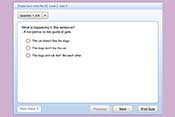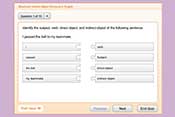
Ser and Estar: Level 1 Quiz 1
Go to Quiz »
More Information
In this quiz, you are going to practice with verbs Ser and Estar (to be). Remember: Ser is used to express “traits”: 1) time, dates, days of the week, month, seasons; 2) characteristics of the subject (size, color, shape, nationality, religion); 3) with impersonal expressions; 4) before “de” (of, from) to indicate origin and possession; 5) before “para” (for, to) to indicate intention or a deadline; and 6) with the subject of a sentence when followed by a noun/noun phrase that restates the subject. Estar is used to express “states”: 1) location; 2) the state or condition of a person; and 3) with adjectives normally used with Ser, but that express something unusual.


Ser and Estar: Level 1 Quiz 2
Go to Quiz »
More Information
In this quiz, you are going to practice with verbs Ser and Estar (to be). Remember: Ser is used to express “traits”: 1) time, dates, days of the week, month, seasons; 2) characteristics of the subject (size, color, shape, nationality, religion); 3) with impersonal expressions; 4) before “de” (of, from) to indicate origin and possession; 5) before “para” (for, to) to indicate intention or a deadline; and 6) with the subject of a sentence when followed by a noun/noun phrase that restates the subject. Estar is used to express “states”: 1) location; 2) the state or condition of a person; and 3) with adjectives normally used with Ser, but that express something unusual.


Ser and Estar: Level 2 Quiz 1
Go to Quiz »
More Information
In this quiz, you are going to practice with verbs Ser and Estar (to be). Remember: Ser is used to express “traits”: 1) time, dates, days of the week, month, seasons; 2) characteristics of the subject (size, color, shape, nationality, religion); 3) with impersonal expressions; 4) before “de” (of, from) to indicate origin and possession; 5) before “para” (for, to) to indicate intention or a deadline; and 6) with the subject of a sentence when followed by a noun/noun phrase that restates the subject. Estar is used to express “states”: 1) location; 2) the state or condition of a person; and 3) with adjectives normally used with Ser, but that express something unusual.


Ser and Estar: Level 2 Quiz 2
Go to Quiz »
More Information
In this quiz, you are going to practice with verbs Ser and Estar (to be). Remember: Ser is used to express “traits”: 1) time, dates, days of the week, month, seasons; 2) characteristics of the subject (size, color, shape, nationality, religion); 3) with impersonal expressions; 4) before “de” (of, from) to indicate origin and possession; 5) before “para” (for, to) to indicate intention or a deadline; and 6) with the subject of a sentence when followed by a noun/noun phrase that restates the subject. Estar is used to express “states”: 1) location; 2) the state or condition of a person; and 3) with adjectives normally used with Ser, but that express something unusual.


Ser and Estar: Level 2 Quiz 3
Go to Quiz »
More Information
In this quiz, you are going to practice with verbs Ser and Estar (to be). Remember: Ser is used to express “traits”: 1) time, dates, days of the week, month, seasons; 2) characteristics of the subject (size, color, shape, nationality, religion); 3) with impersonal expressions; 4) before “de” (of, from) to indicate origin and possession; 5) before “para” (for, to) to indicate intention or a deadline; and 6) with the subject of a sentence when followed by a noun/noun phrase that restates the subject. Estar is used to express “states”: 1) location; 2) the state or condition of a person; and 3) with adjectives normally used with Ser, but that express something unusual.


Gustar-like Verbs: Level 1 Quiz 1
Go to Quiz »
More Information
In this quiz, you are going to practice with Gustar-like verbs (to be pleasing). Remember: 1) The noun after the verb is the subject, and the person before the verb is the indirect object (me, te, le, nos, os, les); 2) the verb is conjugated according to the subject; and 3) in case that another verb follows the Gustar-like verb, you have to put always this Gustar-like verb in the third person singular form and add the other verb you are using in infinitive.


Gustar-like Verbs: Level 1 Quiz 2
Go to Quiz »
More Information
In this quiz, you are going to practice with Gustar-like verbs (to be pleasing). Remember: 1) The noun after the verb is the subject, and the person before the verb is the indirect object (me, te, le, nos, os, les); 2) the verb is conjugated according to the subject; and 3) in case that another verb follows the Gustar-like verb, you have to put always this Gustar-like verb in the third person singular form and add the other verb you are using in infinitive.


Gustar-like Verbs: Level 2 Quiz 1
Go to Quiz »
More Information
In this quiz, you are going to practice with Gustar-like verbs (to be pleasing). Remember: 1) The noun after the verb is the subject, and the person before the verb is the indirect object (me, te, le, nos, os, les); 2) the verb is conjugated according to the subject; and 3) in case that another verb follows the Gustar-like verb, you have to put always this Gustar-like verb in the third person singular form and add the other verb you are using in infinitive.


Gustar-like Verbs: Level 2 Quiz 2
Go to Quiz »
More Information
In this quiz, you are going to practice with Gustar-like verbs (to be pleasing). Remember: 1) The noun after the verb is the subject, and the person before the verb is the indirect object (me, te, le, nos, os, les); 2) the verb is conjugated according to the subject; and 3) in case that another verb follows the Gustar-like verb, you have to put always this Gustar-like verb in the third person singular form and add the other verb you are using in infinitive.


Preterit and Imperfect: Introduction
Go to Quiz »
More Information
In this quiz, you are going to practice with both preterit and imperfect tenses. In Spanish, both express past according to the situation. Remember: Preterit is used: 1) to express completed actions/events; 2) actions that began and finished in the past; 3) sudden changes in states of being; 4) quick moments in time; and 5) series of events. Imperfect is used to: 1) repeated, continuous or habitual actions in the past; 2) simultaneous activities; 3) stating age; and 4) events started in the past, but which continue in the future. The imperfect can mean, in English, would or used to.


Preterit and Imperfect: Level 1 Quiz 1
Go to Quiz »
More Information
In this quiz, you are going to practice with both preterit and imperfect tenses. In Spanish, both express past according to the situation. Remember: Preterit is used: 1) to express completed actions/events; 2) actions that began and finished in the past; 3) sudden changes in states of being; 4) quick moments in time; and 5) series of events. Imperfect is used to: 1) repeated, continuous or habitual actions in the past; 2) simultaneous activities; 3) stating age; and 4) events started in the past, but which continue in the future. The imperfect can mean, in English, would or used to.


Preterit and Imperfect: Level 2 Quiz 1
Go to Quiz »
More Information
In this quiz, you are going to practice with both preterit and imperfect tenses. In Spanish, both express past according to the situation. Remember: Preterit is used: 1) to express completed actions/events; 2) actions that began and finished in the past; 3) sudden changes in states of being; 4) quick moments in time; and 5) series of events. Imperfect is used to: 1) repeated, continuous or habitual actions in the past; 2) simultaneous activities; 3) stating age; and 4) events started in the past, but which continue in the future. The imperfect can mean, in English, would or used to.


Direct and Indirect Object Pronouns: in English
Go to Quiz »
More Information
Direct and Indirect Object Pronouns: in English


Direct and Indirect Object Pronouns: Spanish Parts of Speech
Go to Quiz »
More Information
Direct and Indirect Object Pronouns: Spanish Parts of Speech


Direct and Indirect Object Pronouns: Direct Object Pronouns
Go to Quiz »
More Information
In this quiz, you are going to practice with Direct Object Pronouns in Spanish only. The purpose of the quiz is you to become familiar with the pronouns that usually substitute the parts of the speech that function as direct object. Those pronouns are: me, te, lo-la, nos, os, los-las. For lo-la, los-las, you have to pay attention to the gender and number of the direct object. Also, remember that direct object pronouns usually go before the verb unless you are stating a command. In negative sentences, they go between no and the verb, or attached to the verb (in infinitive form).


Direct and Indirect Object Pronouns: Indirect Object Pronouns
Go to Quiz »
More Information
In this quiz, you are going to practice with Indirect Object Pronouns in Spanish only. The purpose of the quiz is you to become familiar with the pronouns that usually substitute the parts of the speech that function as indirect object. Those pronouns are: me, te, le, nos, os, les. You have to pay attention to who is functioning as indirect object in the sence. Also, remember that direct object pronouns usually go before the verb unless you are stating a command. In negative sentences, they go between no and the verb.


Direct and Indirect Object Pronouns: Double Object Pronouns
Go to Quiz »
More Information
In this quiz, you are going to practice with both Direct and Indirect Object Pronouns in Spanish. The purpose of the quiz is you to become familiar with both types of pronouns when they have to work together. Remember: 1) Indirect Object Pronouns go before Direct Object Pronouns; 2) the verb is after the Direct Object Pronoun [IO > DO > verb]; and 3) you use se instead of le-les when these have to be combined with lo-la or los-las. In other words, a sequence as [le la + verb] would not be possible. Instead, it would be [se la + verb]


Subjunctive: Subjunctive and Verbs of Influence
Go to Quiz »
More Information
In this quiz, you are going to work with the Present Subjunctive verb tense when before you have a verb expressing influence. Remember, when you have a verb expressing influence/volition in Present Indicative your next verb has to be conjugated in Present Subjunctive. The only exception is when you do not have a change of subject. In those cases, your second verb has to be in the Infinitive form (TIP: You can know when you have to write the infinitive form instead of Present Subjunctive if you do not see the word que in the sentence).


Subjunctive: Doubt and Denial
Go to Quiz »
More Information
In this quiz, you are going to work with the Present Subjunctive verb tense when before you have a verb expressing doubt and/or denial. Remember, when you have a verb expressing doubt/negation in Present Indicative your next verb has to be conjugated in Present Subjunctive. However, if those verbs which express doubt/negation are negative (i.e.- to doubt vs. not to doubt), you do not have to write your next verb in Present Subjunctive. Finally, when you do not have a change of subject, your second verb has to be in the Infinitive form (TIP: You can know when you have to write the infinitive form instead of Present Subjunctive if you do not see the word que in the sentence).


Subjunctive: Present Subjunctive Review
Go to Quiz »
More Information
In this quiz, you are going to review the Present Subjunctive verb tense. You are going to find from regular to irregular verbs, reflexive verbs, or c-z-ue verbs. Remember: 1) Present Subjunctive is when you (or someone) express your/his-her-their opinion or point of view about another person/object/animal; 2) it always has to be preceded by another verb, which is conjugated as Present Indicative (the regular present you normally use) and expresses either volition, or feelings, or emotions, or doubt, or negation, or uncertainty; 3) regularly, Present Subjunctive is preceded by the word que as well; 4) when you do not have que but you still have a verb conjugated in Present Indicative, you have to write the second verb (that verb which should be in Present Subjunctive) in Infinitive (-ar, -er, -ir); and 5) Present Subjunctive works after words as “cuando” (when), “ojalá” (I wish) because they expresses uncertainty.
